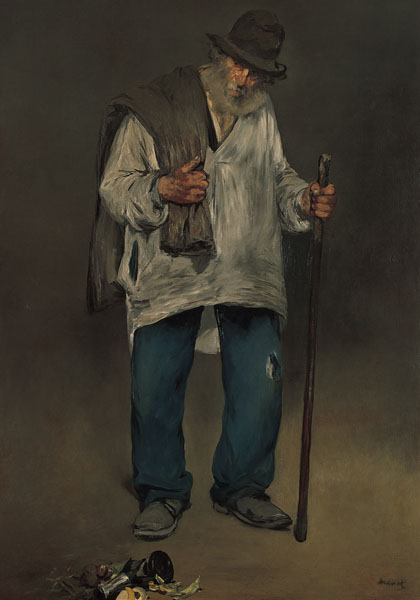Fr : version française / En: english version
mheu, Historical Museum of the Urban Environment
Le chiffonnier (The Ragpicker)
Edouard Manet

1869
194cm x 130cm
oil on canvas
Norton Simon Museum, Pasadena, USA
© The Norton Simon Foundation
View this work in the exhibition Les Chiffonniers
The work
The Ragpicker (1869) belongs to Manet's naturalistic period. It was painted ten years after The Absinthe Drinker (1859), which had earned the artist his first rejection by the Salon, and which also depicted an alcoholic ragpicker in a top hat. This man, wearing a bowler hat and with his white beard, has slightly more the look of a philosopher than the first—a romantic vision then depicted the ragpicker as a free man, working whenever the mood struck.
It is possible to see in the figure painted in 1869 a form of tribute to Baudelaire, Manet's drunken-poet-philosopher friend who had died two years earlier. Be that as it may, the style is still influenced by Velázquez here, in particular by Menippus, which the French ragpicker resembles very closely. Manet adored Velázquez's painting, it is true, but Napoleon III had also just married a beautiful Spanish woman, Spain was in fashion, and the Frenchman was hungry for success and recognition.
Yet the naturalism of his painting once again shocked the public—and of course filled Emile Zola with enthusiasm. He had championed Manet at the 1866 Salon, had become his friend and had his portrait painted by him in 1868.
The artist
Edouard Manet's father, Auguste Manet, was a senior civil servant at the Ministry of Justice. His mother, née Fournier, was a diplomat's daughter. It was into this bourgeois environment that Edouard Manet was born at 5 Rue Bonaparte on January 23, 1932. He was a mediocre pupil, an impudent boy who spent his time caricaturing his teachers. Auguste wanted his son to study law, but Edouard chose the navy and embarked on a training ship bound for Brazil at the age of 16. However, upon failing his entrance exams to naval college on his return, he decided to become a painter.
In 1849, Manet entered the studio of Thomas Couture. He remained there for six years, during which time he learnt about painting, copied masterpieces at the Louvre (Titian, Rubens), traveled (Holland, Italy, Germany, Central Europe), and yet did not manage to win over his master. He exhibited his first painting at the 1859 Salon: the Buveur d'absinthe (The Absinthe Drinker), influenced by Velázquez of whom Manet later wrote in a letter to Baudelaire that he was "the greatest painter there ever was". This was to be his first snub: the painting was rejected on the grounds of its triviality (the naturalism) and its unfinished appearance.
The second snub was a genuine scandal: in 1863, Manet exhibited three works at the Salon des Refusés, two Spanish themes and the famous Déjeuner sur l'herbe (Luncheon on the Grass). The coarseness, the violence of the colors, the obscenity of the subject, all contributed to making the painting unacceptable in its time. Two years later, he began again by exhibiting a deliberately provocative painting, Olympia, which caused such an outcry that the painter was quite shaken. Recognition came some ten years later when art dealer Durand-Ruel finally sold some of Manet's paintings. Revered by the young Impressionists, Manet supported their approach and took to painting outdoors. But after 1876, suffering from a serious neuromuscular disease, he no longer left his studio. Racked with pain, he painted his last great work in 1882 (Bar at the Folies Bergères). He had his left foot amputated on April 19, 1883, and died not long afterwards on April 30 after suffering intense pain that his sister-in-law Berthe Morisot described as "horrific".